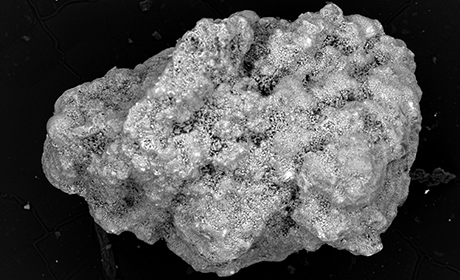Is There Organic Matter on Mars?
13 November 2014

Photo: Bastian Baecker (Heidelberg University / Max-Planck-Institut für Chemie, Mainz), Luigi Folco (Pisa University) and Carole Cordier (Grenoble University)
Scanning electron microscope image of a micrometeorite. These micrometeorites were collected on Earth (Antarctica). It is assumed that every year a large amount of micrometeorites of similar composition falls on Mars. When heated, a fraction of the organic matter might be converted to chloromethane.Organic matter recently detected by NASA’s robotic rover “Curiosity” is probably not due to contamination brought from Earth as researchers originally thought. A team of German and British scientists led by geoscientist Prof. Dr. Frank Keppler from Heidelberg University now suggests that the gaseous chlorinated organic compound – chloromethane – recently found on the “Red Planet” most likely comes from the soil of Mars, with its carbon and hydrogen probably deriving from meteorites that fell on the planet’s surface. This assumption is supported by isotope measurements made by the scientists in which they replicated some of the Mars lander experiments. In these investigations, samples from a 4.6 billion old meteorite that fell in Australia in 1969 were used. Results from this study have been published in “Scientific Reports”.
The question of whether there is organic matter on Mars, an essential requirement for life on this planet, has been debated by the scientific community for a long time. To address this issue, the NASA Curiosity rover, which landed on Mars in August 2012, has conducted investigations on Martian soil. Upon heating soil samples simple organic molecules were detected and identified by on-board measurement systems. One of the substances detected was chloromethane, which contains carbon, hydrogen and chlorine atoms. In the opinion of the NASA experts, however, this compound could have been formed during the soil heating experiments by a reaction between perchlorates in Martian soil and an on-board chemical. Thus, even though the chlorine in the chloromethane comes from Mars, the carbon and hydrogen were considered to have been brought to Mars by the Curiosity rover. Interestingly this kind of organic material had also been identified in earlier experiments during the Viking mission in 1976, but the compound was considered a terrestrial contaminant.
The German-British team of scientists led by Prof. Keppler has investigated whether there could be another explanation for the observations of chloromethane on Mars. They assumed that the gaseous chlorinated organic compound is indeed derived from Martian soil, but that its carbon and hydrogen are provided by meteorites. To support their hypothesis, the researchers examined samples from a 4.6 billion years old meteorite that fell on earth in 1969 near the Australian city of Murchison. According to Prof. Keppler this meteoritic material contains two per cent carbon. Space experts assume that a relatively large amount of micrometeorites with a similar composition to the one of Murchison fall on the surface of Mars each year.
When Frank Keppler and his colleagues heated the Murchison meteoritic matter in the presence of chlorine they observed chloromethane. “The ratio of heavy to light carbon and hydrogen atoms, known as the isotopic fingerprint of a gas, clearly shows that the organic material has an extraterrestrial origin,” Prof. Keppler says. The scientists transferred their results to Martian surface conditions which receive meteorites of similar composition. “Hence chloromethane which was found by the two separate Mars missions could be formed by the Martian soil, and the carbon and hydrogen would have their origin in the micrometeorites that rain down on Mars,” explains Prof. Keppler. “However, it cannot be ruled out that microorganisms which might have been living on the planet some time ago might have provided a fraction of the organic matter.” The Heidelberg scientist assumes that in future Mars missions the isotopic fingerprint of the chloromethane could determine whether its origin is from organic material that is indigenous to Mars, was deposited by meteorites or is contamination from the landers sent from Earth.
Frank Keppler leads the Biogeochemistry working group at Heidelberg University's Institute of Earth Sciences. In addition to scientists from Heidelberg, experts from the Max Planck Institute of Chemistry in Mainz and the School of Biological Sciences at Queen‘s University in Belfast contributed to this research.
Original publication:
F. Keppler, D.B. Harper, M. Greule, U. Ott, T. Sattler, G.F. Schöler & J.T.G. Hamilton: Chloromethane release from carbonaceous meteorite affords new insight into Mars lander findings. Scientific Reports 4 : 7010 (13 November 2014), doi: 10.1038/srep0701

